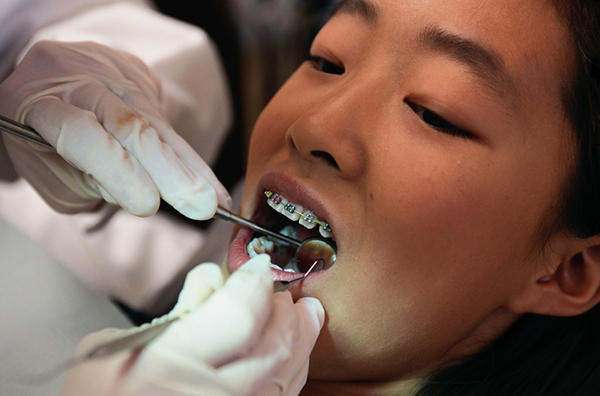The process of developing speech is a complicated one. Children spend years, starting from just a few months old, on learning to develop the skills necessary to process and express words. One major milestone in the process is the eruption of their teeth. Teeth and speech problems go hand-in-hand when teeth erupt in a less than ideal way.
There are several types of speech problems that can be present in your child’s behavior depending on the positioning and spacing of their teeth. Orthodontic treatment will not only correct their tooth placement for a healthier development, but it can also work towards treating issues with their developing or developed speaking skills!
If your child has a speech problem, you may want to make an appointment with an orthodontist along with a speech therapist. Read on to learn more about how teeth and speech problems are connected, and what you can do as a parent to aide your child.
#1 Lisping
Lisping is one type of speech defect that affects a person’s ability to properly pronounce sounds associated with the letters “s” or “z.” Instead of the correct sound, it comes out with one similar to words ending in “th” like in “path.”
Overbites, underbites, and gaps are primary causes for lisping. Overbites occur when there is too much of an overlap between the upper teeth and the bottom teeth. Underbites are similar, but with the lower teeth overlapping the upper teeth. When it comes to gaps within the teeth, these problems are usually easy to spot as you can see a clear space between teeth when they should be generally positioned close to each other uniformly.
These types of misalignments in teeth, or extra gaps, can be treated with routine orthodontics. This ranges from traditional braces to possibly even Invisalign depending on the individual person. If lisping is caused by their tooth placement, treatment should either resolve the lisping or provide them with a dental environment where speech therapy can easily help them learn to properly form the “s” or “z” sounds.
It is possible that lisping could have alternative causes. Things ranging from tongue placement to issues like being tongue-tied are other common reasons children develop lisps.
#2 Slurring or Whistling
If there is not enough room for the tongue—which is often the case with crossbites or underbites—speech is often affected. This is caused when the structure of the jaw or placement of teeth restricts movement of the tongue. One of the main goals of orthodontic treatment is not just to fix visible issues with the teeth, but to reposition them so the development of your child’s mouth and jaw follow a healthy progression. When caught early, issues that may lead to speech slurring can not only be corrected by orthodontic treatment, but it will help avoid issues that may not present until years later due to crowding or alignment issues.
Similarly, alignment issues that lead to gaps can cause misplacement of the tongue while speaking and allow air to escape. The result is an audible whistling sound during speech that happens more frequently than the occasional accidental whistle that many of us do. In these situations, braces can often open up room for the tongue by fixing the alignment of the teeth and preventing the unusual airflow that causes accidental whistling.
#3 Mispronouncing Consonant Sounds
We associate certain speech impediments with age and development, but sometimes it’s just because children are trying to speak words without the right tools – like a full set of teeth! As children’s baby teeth erupt and fall out, speech is directly affected.
It makes sense then that when teeth are not where they are supposed to be due to orthodontic issues, certain sounds are difficult to pronounce. Sounds that require the tongue to connect with the teeth—like “S,” “T” or “Ch”—are most impacted. Another type of sound comes from words formed by pressing the tongue against the upper ridge near the roof of their mouth. These are sounds like “n” or “d.”
If there is an opening—similar to what is found in overjets (sometimes known as buck teeth) and open bites—the tongue creates the seal instead and causes mispronunciation. Orthodontic treatment can improve pronunciation by aligning teeth correctly.
What’s the Best Age to Seek Orthodontic Treatment for a Speech Problem?
According to the American Association of Orthodontists, it is recommended that all children be evaluated by age 7. After the age of 10, children are more significantly affected by language impairment. Just like any developmental concern, the earlier it’s treated, the better the outcome typically is. Speech can be a hard skill to change once children develop habits formed by orthodontic issues.
Faster treatment can make it easier for them to develop more normalized speech. This can help them avoid issues like lower self-esteem and poor self-image compared to the children with no speech impediments.
In the past it was often a worry for children to adjust to life with braces. But orthodontic science has come a long way, and the long-term benefits far outweigh any temporary adjustments a child may have to make.
While issues with teeth can cause speech issues, correcting your child’s bite many not be the only step required to improve their speech. For more difficult issues, you can often work with speech therapists—who are usually available through school systems and can work with the children on word and sound pronunciation while they have braces and afterward.
If your child is struggling, incorporating orthodontics into their speech problem treatment may be the way to relief.
Schedule a Free Consultation
Want to learn how you can incorporate orthodontics in your child’s speech problem treatment? Find out how we can help by scheduling a free consultation! Contact us online or call 440-842-8015
Stay connected with Doctor Andy on Social Media!





